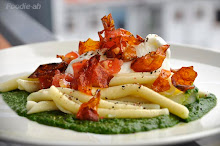
Ragù is a term deriving from French (ragôut) to indicate sauces based on a combination of meat, vegetables and tomatoes. There is an official recipe for Ragù Bolognese, which has been agreed upon and deposited with the Bologna Chamber of Commerce. More detailed information on the original recipe can be found here. Since this is a blog, I will describe my own recipe, which is pretty similar to the original, with a few variations primarily constrained by availability of the ingredients.

Although the original recipe is only based on beef, nowadays people tend to use 50% beef and 50% pork to "lighten" the sauce. I personally like pork, so I went for the 50-50 mix. I decided to use beef brisket, which is a fairly inexpensive, tasty cut, ideal for prolonged cooking. I mixed the brisket with as much pork, some of which was belly and some of which was shoulder. I didn't buy minced beef/pork, since I like to chose the exact cut I want, and also because hand-shredded meat results into a different texture. I hand-chopped the beef and pork, and then I lightly minced 40% of it using an immersion blender. The result can be seen in the picture above.

I used the following ingredients:
- 2 tinned plum (Roma) tomatoes
- 300ml Milk
- 200ml stock (chicken or beef)
- A glass of red wine
- 200g each of carrot, celery and onion
- 300g of bacon, some of it smoked
- 1.3 Kg of meat, 50% beef brisket, 30% pork shoulder, 20% pork belly

One ingredient that is hardly available to the public in Singapore is pancetta. This is not commonly sold in supermarkets/butchers, and even if you could get hold of it, it would probably be too expensive to be fried into a Bolognese sauce. For this reason, I recommend to use some quality bacon instead.
Start by removing the fat from the pork belly, and rendering it in a non-stick pan, without any added oil. When the fat almost completely melted, discard the remaining lumps of fat and skin, and add the chopped bacon. Fry it gently for about 10-15 mins until crispy, then add the finely chopped carrots, onions and celery, to make what in Italy we call soffritto. These need to be sweat slowly for about 15 minutes until soft, then removed from the pan.

Time to add the chopped beef and pork, mixing vigorously to rapidly expose it to the heat throughout. As it will start cooking, the meat will release a lot of juice which you will need to evaporate completely. It is very important that the meat is cooked in isolation from the vegetables, in order to remove all of its liquid content and sear it by causing a Maillard reaction. You should really start smelling the same aromas that steaks release when you pan fry them. This process can take about 30 minutes for 1.3 Kg of meat.

You can clearly see in the two pictures above the difference in texture and color between beef that has just been turned and heated thoroughly and is still juicy, and the one below, which has been dried out and is crispy and tasty. As Gordon says: "no color - no flavour"- and you will hardly get color on the meat if you mix soffritto and meat all together, due to the different cooking times. You can then deglaze the pan on high heat with a glass of red wine, mixing rapidly to detach any bits of meat stuck at the bottom of the pan. When all the alcohol is evaporated, pour the soffritto back into the pan, add the tomatoes and the stock, and let the sauce simmer gently for about 3-4 hours. You will need to regularly check progress, stir the sauce and make sure that it does not dry out, adding water if required, and milk in the quantities indicated towards the end of the cooking process. Add salt if required, when most of the juices are evaporated.

Once the sauce is ready, either serve immediately or freeze for later use. If you decide to freeze it, make sure that you cool it down rapidly by placing the pan with your kitchen sink filled up with water, and changing the water continuously as it heats up. When the sauce is at room temperature (this should happen within 15 minutes or so), place it into freezer bags, seal them, then put them into an ice bath (made of 30% water and the rest of ice) for about 10-15 minutes, until they are very cool, and then place them in the freezer.








3 comments:
i didn't know using pork will be so flavourful. i used 50% lean beef-50% pork shoulder instead to save the calories.
do share more recipes! thanks.
la
Hi Foodieah
I realised that there is no herb in this recipe - is this meant to be that way? (other recipe would have called for baf leaves, rosemary etc)
ps- love the tips abt not mixing the soffritto and meat while cooking the meat - no one told me!
Alice
Hi Alice. Good point!
The classic ragu alla bolognese is a deposited recipe with the Italian Academy of cooking:
http://www.gvci.org/index.php?option=com_content&view=article&id=572&Itemid=975
As you can see from the official deposited classic recipe, there are no herbs or seasonings except from salt and pepper.
Obviously people can enrich the taste with whatever they prefer. I would recommend for this recipe basil or thyme are a good match by Italian standards.
Post a Comment